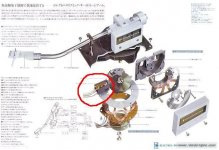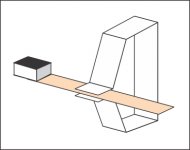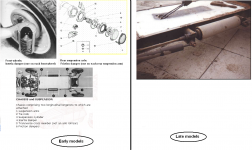From you description (although I am bit lost between "ups" and "downs") I make out that the opposing magnets act as a spring. But what is causing energy dissipation (=heat generation)? Analogous to a car suspension, there is mass of the body, suspension springs and shock absorbers providing damping. Damping indeed is ignored in most tonearms, unlike at the Townshend solution.
If the magnets act as a spring alone, isn't that damping?
Damping - Simple English Wikipedia, the free encyclopedia
I've considered the tuned mass idea, used to great effect by Renault F1 team until it was banned (and then the inerter came along), but the scaling is an issue. Two things that possibly warrant more considering are
1. A Townshend style trough but with some springiness between headshell and paddle.
2. Revisiting solenoid VTF. Complex but in theory with 'active suspension' you could do all sorts of interesting stuff. But a stick in goop is easier 🙂
1. A Townshend style trough but with some springiness between headshell and paddle.
2. Revisiting solenoid VTF. Complex but in theory with 'active suspension' you could do all sorts of interesting stuff. But a stick in goop is easier 🙂
No, a spring is not the same as a damper, unless the deformation of the spring causes energy to be converted into heat, which will not be the case with magnets.If the magnets act as a spring alone, isn't that damping?
Hiten's idea in posting #934 can very well be used in a vertical way.
A tube filled with oil with a snug fit body inside held into the middle position by to springs. A small hole into the body will allow the body to move up and down, converting energy into heat and acting as a damper.
This is exactly the shock absorber on a Citroen 2CV.
Hans
Well, it really doesn't matter what you call this kind of effect. As long as it reduces the the amplitude of vibrations in vertical plane, it works for me. I believe it will.
Damping is any effect that tends to reduce the amplitude of vibrations. This is what I think.
Damping is any effect that tends to reduce the amplitude of vibrations. This is what I think.
I am also looking for an effective no-friction damping means. With all due respect, the viability of your idea is yet to prove.
I am also looking for an effective no-friction damping means. With all due respect, the viability of your idea is yet to prove.
You are 100% right. It is just an idea. However, it is not difficult to try it out on my arm. I will try it out in days.
For vertical damping as Hans has said springs or a steel ball rested on synthetic sponge in liquid fillled tube should also work I guess. OR we can use leaf spring as shown in picture. a metal spring clamp holds the springy leaf which has weight attached at the end; by sliding the holding point I think one can tune the damping mass.
Regards
Regards
Attachments
Hiten's idea in posting #934 can very well be used in a vertical way.
A tube filled with oil with a snug fit body inside held into the middle position by to springs. A small hole into the body will allow the body to move up and down, converting energy into heat and acting as a damper.
This is exactly the shock absorber on a Citroen 2CV.
On the original and all early 2CV models up to around 1960:
The front wheels dampers were actually suspended mass inertia dampers, the suspended mass resting on a spring. The tinny oil quantity inside was only for lubricating the up-down sliding sides of the suspended mass .
The rear axle dampers were spring loaded, rotating friction plates.
On the later models these front and rear mechanical dampers were replaced with ordinary hydraulic pots horizontally placed, damping this action of the ingenious, simple spring suspension system of the 2CV:
Entmontage - Technik Fahrwerk
George
Attachments
... and I will try the eddy current damping, seen on these videos:
Magnetic Damping
Neodymium magnet over copper plate
Copper pipe and neodymium magnet
Strong magnet falls on copper plate
Magnetic Damping
Neodymium magnet over copper plate
Copper pipe and neodymium magnet
Strong magnet falls on copper plate
My worry about eddy current damping is that it works better the more velocity you have, and for cartridge damping the movements are very very small. Or to put it another way, great for slowing down a Garrard motor.
My worry about eddy current damping is that it works better the more velocity you have, and for cartridge damping the movements are very very small. Or to put it another way, great for slowing down a Garrard motor.
I would worry about having big N50 magnets near a cart.
They'd be at least 10" away. I know dynavector used it on the DV507 and owners of that seem to like it, despite it appearing to have traded one problem for a whole host of others!
In my view, a brush type damper does the most important task of reducing cantilever deflection due to warps and off centre hole.
Any platform referenced damper increases these factors
Any platform referenced damper increases these factors
In my view, a brush type damper does the most important task of reducing cantilever deflection due to warps and off centre hole.
Any platform referenced damper increases these factors
Hi David
Re eccentricity effect damping: I have seen minimal to nil difference from engaging the M97 brush.
George
They'd be at least 10" away.
You need some of those near room temperature superconductors from you know who.
Hi George,On the original and all early 2CV models up to around 1960:
The front wheels dampers were actually suspended mass inertia dampers, the suspended mass resting on a spring. The tinny oil quantity inside was only for lubricating the up-down sliding sides of the suspended mass .
The rear axle dampers were spring loaded, rotating friction plates.
On the later models these front and rear mechanical dampers were replaced with ordinary hydraulic pots horizontally placed, damping this action of the ingenious, simple spring suspension system of the 2CV:
Entmontage - Technik Fahrwerk
George
Energy never gets lost, but it can be converted from one form of energy into another one, like motional energy into heat energy.
A mass being pushed into a spring, with no friction at all, would go up and down forever after release, in that way doing a very bad job as a shock absorber.
Either friction between inside moving mass and tube or alternative air or some liquid moving from the lower to the upper chamber and vice versa being forced through a restrictive hole in the moving mass, absorbs motional energy and converts it into heat thereby damping the motion.
Blow some air through a small hole and you will notice that it will become hot, meaning that some of the energy in the moving air from your breath has been converted into heat.
Hans
... and I will try the eddy current damping, seen on these videos:
Magnetic Damping
Neodymium magnet over copper plate
Copper pipe and neodymium magnet
Strong magnet falls on copper plate
I did eddy current damper. But I was not sure if it worked as I expected so I took it off. However, I don’t think the result was conclusive because I didn’t run further tests to see if it worked and I was not sure eddy current worked at low velocity as Bill pointed it out. Anyway, eddy current is for lateral damping. For a linear arm, in my opinion, vertical damping is more important than lateral damping. I don’t see the need to reinstall it again.
In early model of Versa Dynamics arm, they used eddy current damping device but not on their later model. Why did they feel they didn’t need eddy current damping? I have no idea.
Last edited:
A mass being pushed into a spring, with no friction at all, would go up and down forever after release, in that way doing a very bad job as a shock absorber.
I agree Hans. Not much of friction (true, I have checked it in the past), means that the early 2CV front damper functions as a carefully tuned mass damper (working under the conservation of momentum principle)
George
- Home
- Source & Line
- Analogue Source
- Turntable speed stabilty


